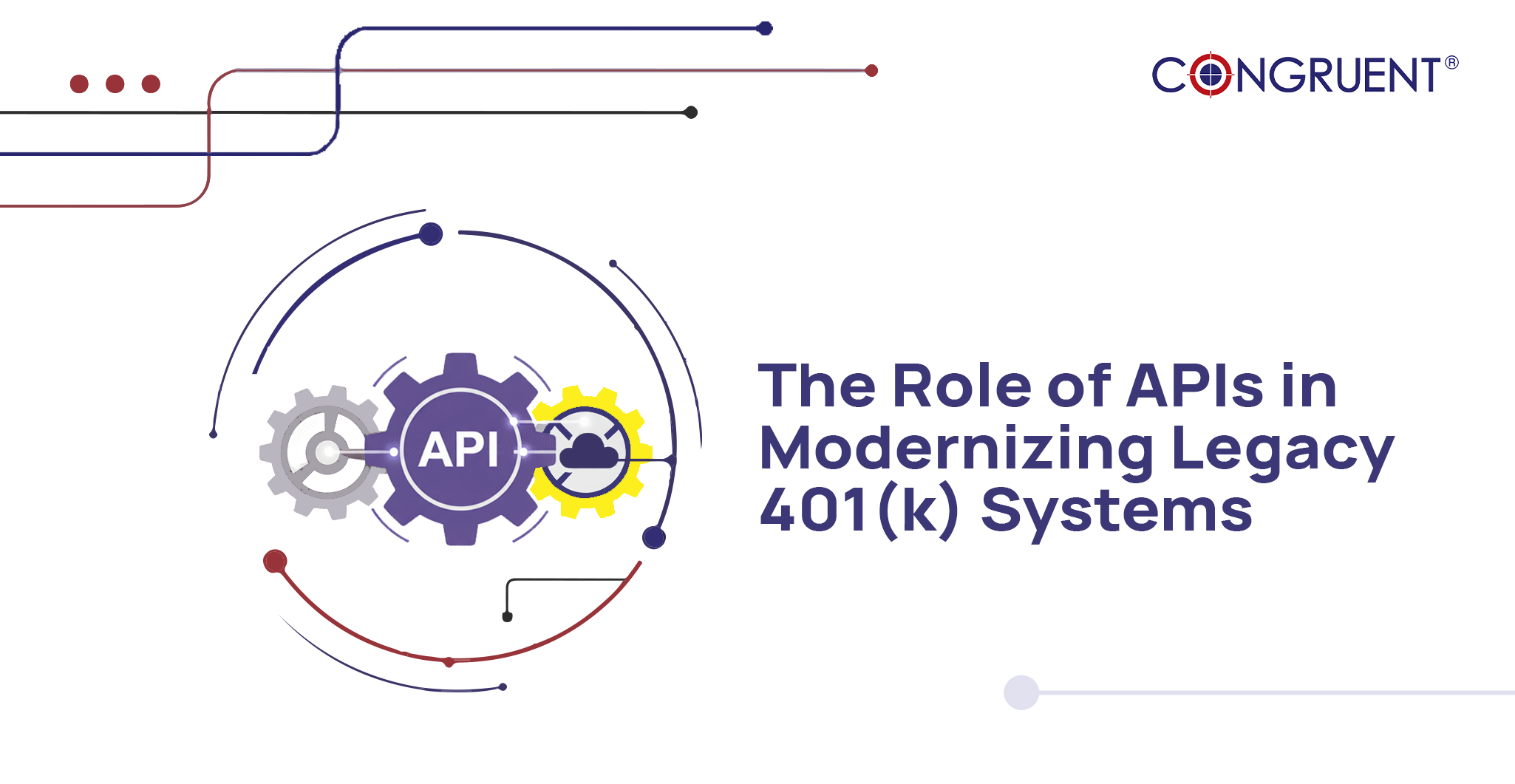
Outdated technology, fragmented data, and manual processes hinder operational efficiency, compliance, and plan participant satisfaction. 401(k) retirement plan administration service providers, recordkeepers, and Third-Party Administrators (TPAs) must stay on top of technological advancements to thrive amidst the rising competition.
Application Programming Interfaces (APIs) transform legacy 401(k) systems by enabling seamless communication between software, simplifying integration, streamlining processes, and enhancing functionality.
This article discusses how APIs are helping 401(k) retirement plan administration service providers, recordkeepers, and TPAs to improve participant experience, increase efficiency, and stay ahead in the industry.
The challenges of legacy 401(k) systems
Legacy recordkeeping and plan administration systems struggle to meet the complexity, high volume, and customization demands of modern 401(k) plans. These legacy systems are outdated, siloed, and lack the flexibility to adapt to changing rules and markets.
The key challenges with legacy 401(k) retirement plan solutions are:
- Outdated architecture limits the flexibility and scalability needed for today’s complex, high-volume 401(k) plans.
- Siloed systems hinder data flow and make cross-platform integration difficult.
- Batch processing delays prevent real-time updates, frustrating participants seeking instant access.
- Costly custom integrations with payroll and HRIS systems strain IT and operational resources.
- Manual processes increase the chances of errors, especially under evolving regulations like SECURE 2.0.
- High operational costs due to duplicate manual processes and a lack of automation.
- Poor user experience from limited digital capabilities and outdated interfaces.
APIs help to address these challenges and provide a flawless participant experience while maintaining compliance and operational scalability.
Why APIs matter for 401(k) systems
APIs act as digital connectors between different 401(k) retirement plan systems, allowing data to move quickly, securely, and accurately across platforms. 401(k) recordkeepers, TPAs, and retirement plan administrators can rely on APIs to streamline operations, reduce manual touchpoints for participants, and ensure secure collaboration with regulators.
Here are some ways APIs help modernize and improve 401(k) systems:
- Secure and seamless data sharing: APIs eliminate the need for manual file uploads by allowing efficient and secure data exchange between recordkeeping, payroll, HRIS, and third-party systems.
- Real-time information access: Unlike batch processing legacy systems, APIs allow real-time updates, ensuring regulators, participants, and sponsors always see the most current data on contributions, balances, and transactions.
- Reduce operational overhead: By automating data transfers and processes, APIs reduce administrative burden, minimize errors, and lower ongoing participant support and maintenance costs.
- Improved participant experience: Integrated data flows improve participant satisfaction and engagement by making account access, updates, and self-service faster and more intuitive.
- Faster and easier integrations: APIs reduce IT complexity when integrating with payroll providers, custodians, investment platforms, and other partners.
- Enhanced compliance and accuracy: APIs help recordkeepers and TPAs comply with mandates like SECURE 2.0 by supporting real-time data validation and timely regulatory reporting.
- Scalability and future-readiness: API-driven systems are more adaptable to future technologies and business models, enabling retirement plan administrators and recordkeepers to scale as plan complexity grows.
How APIs drive modernization for 401(k) retirement plan administrators and recordkeepers
APIs enable systems to communicate in real time and facilitate interoperability between different technologies. This is especially important for retirement plan administrators and recordkeepers managing the rising volumes and complexities of 401(k) plans with multiple stakeholders and regulations.
The SPARK Institute’s API framework, introduced in June 2025, offers voluntary best practices to standardize data exchange across the 401(k) ecosystem. By adopting these guidelines, stakeholders can streamline tasks like contribution updates, eligibility checks, and loan tracking.
APIs eliminate the need for costly custom integrations by providing unified access to multiple payroll software and HRIS platforms, a game-changer for recordkeepers managing diverse client portfolios. For TPAs, automated data flows reduce manual workloads, boosting accuracy and scalability. SPARK’s emphasis on secure, real-time transmission ensures compliance with regulatory requirements, improving the operational efficiency of retirement plan administrators.
Most importantly, APIs help retirement industry stakeholders reduce development costs and implementation time. Implementing APIs makes digital transformation a practical and scalable reality for plan administrators and recordkeepers operating on thin margins.
Become API-ready and SPARK-aligned with Congruent Solutions
APIs transform the retirement industry by enabling real-time data sharing and seamless integration. They are helping replace outdated recordkeeping and plan administration systems with scalable and modern platforms without disrupting entire workflows.
Whether you’re a recordkeeper seeking real-time data sharing, a plan administrator looking to boost participant engagement, or a TPA looking to automate tasks, Congruent Solutions delivers modern solutions aligned with SPARK’s vision of interoperability and efficiency. We understand the challenges of moving from legacy systems and offer APIs tailored to your needs. Our decades of expertise, along with ISO 27001:2013 and SOC2 Type II certifications, underscore our commitment to data security, giving you peace of mind as you modernize.
Ready to modernize your 401(k) operations?
Contact Congruent Solutions today for a demo to discover how we can support your API integration journey.
